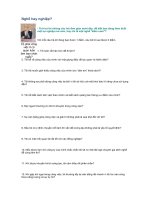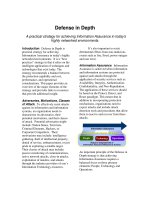Tài liệu Defense in Depth docx
Bạn đang xem bản rút gọn của tài liệu. Xem và tải ngay bản đầy đủ của tài liệu tại đây (187.52 KB, 5 trang )
Defense in Depth
A practical strategy for achieving Information Assurance in today’s
highly networked environments.
Introduction. Defense in Depth is
practical strategy for achieving
Information Assurance in today’s highly
networked environments. It is a “best
practices” strategy in that it relies on the
intelligent application of techniques and
technologies that exist today. The
strategy recommends a balance between
the protection capability and cost,
performance, and operational
considerations. This paper provides an
overview of the major elements of the
strategy and provides links to resources
that provide additional insight.
Adversaries, Motivations, Classes
of Attack. To effectively resist attacks
against its information and information
systems, an organization needs to
characterize its adversaries, their
potential motivations, and their classes
of attack. Potential adversaries might
include: Nation States, Terrorists,
Criminal Elements, Hackers, or
Corporate Competitors. Their
motivations may include: intelligence
gathering, theft of intellectual property,
denial of service, embarrassment, or just
pride in exploiting a notable target.
Their classes of attack may include:
passive monitoring of communications,
active network attacks, close-in attacks,
exploitation of insiders, and attacks
through the industry providers of one’s
Information Technology resources.
It’s also important to resist
detrimental effects from non-malicious
events such as fire, flood, power outages
and user error.
Information Assurance. Information
Assurance is achieved when information
and information systems are protected
against such attacks through the
application of security services such as:
Availability, Integrity, Authentication,
Confidentiality, and Non-Repudiation.
The application of these services should
be based on the Protect, Detect, and
React paradigm. This means that in
addition to incorporating protection
mechanisms, organizations need to
expect attacks and include attack
detection tools and procedures that allow
them to react to and recover from these
attacks.
Information Assurance
People
Technology
Operations
Defense In De pth Strategy
Defense In Depth Strategy
Robust & Integrated Set of
Information Assurance Measures & Actions
An important principle of the Defense in
Depth strategy is that achieving
Information Assurance requires a
balanced focus on three primary
elements: People, Technology and
Operations.
People. Achieving Information
Assurance begins with a senior level
management commitment (typically at
the Chief Information Officer level)
based on a clear understanding of the
perceived threat. This must be followed
through with effective Information
Assurance policies and procedures,
Operations
People
Technology
Information Assurance
Defense In Depth Strategy
• Policies & Procedures
• Training & Awareness
• System Security
Administration
• Physical Security
• Personnel Security
• Facilities
Countermeasures
Hire Good People —Train & Reward Them Well
Penalize Unauthorized Behavior
assignment of roles and responsibilities,
commitment of resources, training of
critical personnel (e.g. users and system
administrators), and personal
accountability. This includes the
establishment of physical security and
personnel security measures to control
and monitor access to facilities and
critical elements of the Information
Technology environment.
Technology. Today, a wide range of
technologies are available for providing
Information Assurance services and for
detecting intrusions. To insure that the
right technologies are procured and
deployed, an organization should
establish effective policy and processes
People Operations
Information Assurance
Technology
Defense In Depth Strategy
• IA Architecture
• IA Criteria
(Security, Interoperability,
PKI)
• Acquisition/Integration of
Evaluated Products
• System Risk Assessment
Application of Evaluated Products and Solutions
Support of a Layered Defense Strategy
for technology acquisition. These
should include: security policy,
Information Assurance principles,
system level Information Assurance
architectures and standards, criteria for
needed Information Assurance products,
acquisition of products that have been
validated by a reputable third party,
configuration guidance, and processes
for assessing the risk of the integrated
systems. The Defense in Depth strategy
recommends several Information
Assurance principles. These include:
a) Defense in Multiple Places. Given
that adversaries can attack a target
from multiple points using either
insiders or outsiders, an organization
needs to deploy protection
mechanisms at multiple locations to
resist all classes of attacks. As a
minimum, these defensive “focus
areas” should include:
Information Assurance
People
People
Tech nology
Technology
Operations
Operations
Defense In Depth Strategy
Defense In Depth Strategy
Defend the
Network &
Infrastructure
Defend the
Computing
Environment
Supporting
Infrastructures
Defend the
Enclave
Boundary
Detect &
Respond
KMI/PKI
Defense in DepthFocus Areas
Defense in Depth Focus Areas
• Defend the Networks and Infrastructure
- Protect the local and wide area
communications networks (e.g. from
Denial of Service Attacks)
- Provide confidentiality and integrity
protection for data transmitted over
these networks (e.g. use encryption and
traffic flow security measures to resist
passive monitoring)
• Defend the Enclave Boundaries (e.g.
deploy Firewalls and Intrusion
Detection to resist active network
attacks)
•
Defend the Computing Environment
(e.g. provide access controls on hosts
and servers to resist insider, close-in,
and distribution attacks).
b) Layered Defenses. Even the best
available Information Assurance
products have inherent weaknesses.
So, it is only a matter of time before
an adversary will find an exploitable
Examples of Layered Defenses
Class of First Line of Second Line of
Attack Defense Defense
Passive Link & Network Layer
Encryption and
Traffic Flow Security
Security Enabled
Applications
Active Defend the Enclave
Boundaries
Defend the Computing
Environment
Insider Physical and Personnel
Security
Authenticated Access
Controls, Audit
Close-In Physical and Personnel
Security
Technical Surveillance
Countermeasures
Distribution Trusted Software
Development and
Distribution
Run Time Integrity
Controls
vulnerability. An effective
countermeasure is to deploy multiple
defense mechanisms between the
adversary and his target. Each of
these mechanisms must present
unique obstacles to the adversary.
Further, each should include both
“protection” and “detection”
measures. These help to increase
risk (of detection) for the adversary
while reducing his chances of
success or making successful
penetrations unaffordable.
Deploying nested Firewalls (each
coupled with Intrusion Detection) at
outer and inner network boundaries
is an example of a layered defense.
The inner Firewalls may support
more granular access control and
data filtering.
c) Specify the security robustness
(strength and assurance) of each
Information Assurance component as
a function of the value of what’s it is
protecting and the threat at the point
of application. For example, it’s
often more effective and
operationally suitable to deploy
stronger mechanisms at the network
boundaries than at the user desktop.
d) Deploy robust key management and
public key infrastructures that
support all of the incorporated
Information Assurance technologies
and that are highly resistant to attack.
This latter point recognizes that these
infrastructures are lucrative targets.
e) Deploy infrastructures to detect
intrusions and to analyze and
correlate the results and react
accordingly. These infrastructures
should help the “Operations” staff to
answer questions such as: Am I
under attack? Who is the source?
What is the target? Who else is
under attack? What are my options?
Operations. The operations leg
focuses on all the activities required to
sustain an organization’s security
posture on a day to day basis.
People
Information Assurance
Defense In Depth Strategy
Technology
Operations
• Security Policy
• Certification and
Accreditation
• Security Mgmt.
• Key Management
• Readiness
Assessments
• ASW&R
• Recovery &
Reconstitution
Enforce Security Policy
Respond Quickly to Intrusions
Restore Critical Services
These include:
a) Maintaining visible and up to date
system security policy
b) Certifying and accrediting changes to
the Information Technology
baseline. The C&A processes should
provide the data to support “Risk
Management” based decisions.
These processes should also
acknowledge that a “risk accepted by
one is a risk shared by many” in an
interconnected environment.
c) Managing the security posture of the
Information Assurance technology
(e.g. installing security patches and
virus updates, maintaining access
control lists)
d) Providing key management services
and protecting this lucrative
infrastructure
e) Performing system security
assessments (e.g. vulnerability
scanners, RED teams) to assess the
continued “Security Readiness”
f) Monitoring and reacting to current
threats
g) Attack sensing, warning, and
response
h) Recovery and reconstitution
Additional Resources. The National
Security Agency, with support from
other U.S. Government Agencies and
U.S. Industry, has undertaken a number
of initiatives to support the Defense in
Depth strategy. These include:
a) The Information Assurance
Technical Framework. This
document provides detailed
Information Assurance guidance for
each of the Defense in Depth focus
areas. It is available at
b) The National Information Assurance
Partnership (NIAP). This is a
partnership between NSA and NIST
to foster the development of the
International Common Criteria (an
ISO standard) and to accredit
commercial laboratories to validate
the security functions in vendor’s
products. Information on this
activity is available at
c) Common Criteria Protection Profiles.
These are documents that
recommend security functions and
assurance levels using the Common
Criteria. They are available for a
wide range of commercially
available technologies and can be
accessed at the IATF or the NIAP
web sites listed above.
d) List of Evaluated Products. These
are lists of commercial Information
Assurance products that have been
evaluated against the Common
Criteria. The lists are maintained by
NIST and are available at the NIAP
web site.
e) Configuration Guidance. These
documents, being prepared by NSA,
contain recommended configurations
for a variety of commonly used
commercial products.
f) Glossary of Terms. The National
Information Systems Security
(INFOSEC) Glossary, dated
September 2000, can be found at:
009.pdf
Feedback. Please address questions or
comments on this paper by email to
or by mail to:
National Security Agency
Attention:
Information Assurance
Solutions Group – STE 6737
9800 Savage Road
Fort Meade, MD 20755-6737









